Tent Caterpillars
ENTFACT-424: Tent Caterpillars | Download PDF
by Joe Collins, Nursery Inspector
University of Kentucky College of Agriculture
Tent caterpillars live in groups within a silken tent. The silk is produced by glands in the head and the tent provides protection from many natural enemies. There are three species of tent caterpillars in Kentucky, USA: the eastern tent caterpillar, forest tent caterpillar, and fall webworm.
Each of these pests has a wide array of natural enemies that usually keep caterpillar populations from becoming large. Harsh weather conditions may also kill many caterpillars. However, one or more of the species may be very common during some years. Although the defoliation and webbing is unsightly, these insects rarely kill a tree. However, heavy feeding during one year may reduce tree growth, especially if there are other stresses such as drought.
Eastern Tent Caterpillar
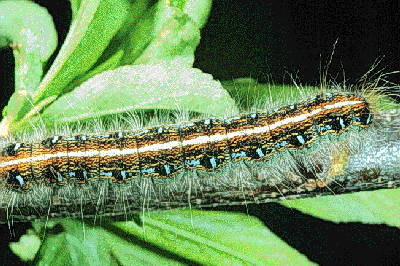
ETC Larva
The eastern tent caterpillar is a native insect that was first reported in 1646. Large numbers of this caterpillar usually occur in intervals of about ten years. Before the gypsy moth was accidentally introduced into the US, the eastern tent caterpillar was considered to be one of our most important pests of shade trees.
Eastern tent caterpillars prefer wild cherry, apple and crabapple. They also will feed on ash, birch, blackgum, redgum, willow, witch-hazel, maple, oak, poplar, cherry, peach and plum.
The insect spends the winter as an egg. The eggs are laid in ring-like masses that encircle small twigs of the host plant. The egg masses look like they are varnished and are about 3/4" long.
The eggs will begin to hatch about the time that wild cherry leaves begin to unfold. After hatching, the small caterpillars begin to construct a tent in a nearby branch fork. The tent becomes larger as the larvae grow. From this tent, the larvae crawl out to the foliage to feed. After feeding, they return to the tent.The larvae are generally black with a white stripe down the back. On the sides of the insect there will be blue spots located between two yellowish lines. This insect pupates inside of whitish-colored cocoons that may be found on tree trunks, fences or buildings. The adults will emerge from the cocoons in late June or early July. The moths are reddish-brown and have two whitish stripes running across each wing. There is only one generation of this insect per year.
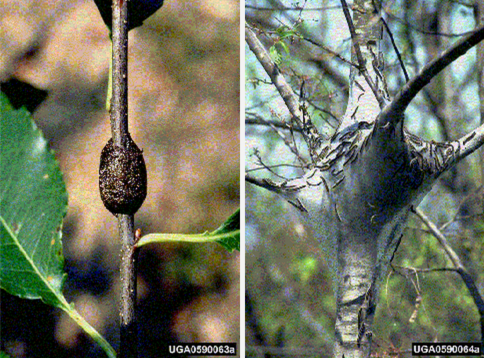
ETC Egg Mass (left) and Tent (right)
Forest Tent Caterpillar
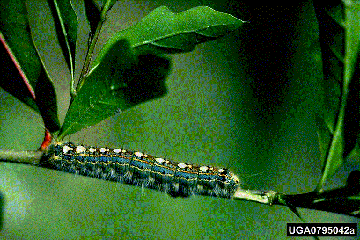
FTC Larva
The forest tent caterpillar is quite similar to the eastern tent caterpillar. The egg masses are laid in similar fashion as the eastern tent caterpillar but are square at the ends. When the eggs hatch, the larvae form a loose tent or mat on the trunk or branch of a tree. From this, they will usually move to the top of the tree to start feeding on the expanding leaf buds. After the buds open, they start feeding on foliage. Usually the larvae will concentrate their feeding on one branch at a time. The larvae return to the mat to rest or to molt.
This caterpillar can be distinguished from the eastern tent caterpillar by the keyhole-shaped spots along its back. Full-grown larvae have light-blue heads speckled with black and are sparsely covered with fine, whitish hairs.
The forest tent caterpillar pupates in a yellow cocoon that is spun in folded leaves that are attached to the tree. The adult is a tan moth, about 1-1/2 inches long with two dark brown stripes on each of the front wings. There is one generation per year. Trees attacked by this insect include sweetgum, oak, birch, ash, maple, elm and basswood.
Fall Webworm
The fall webworm is a pest that is distributed throughout most of the United States and Canada. It will feed on almost all shade, fruit and ornamental trees except for evergreens. In Kentucky some of the preferred trees include American elm, maples, hickory, and sweetgum.
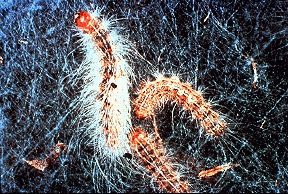
Fall Webworm Larva
The fall webworm differs from the eastern tent caterpillar and the forest tent caterpillar in that fall webworms always place their tent on the end of branches and there is usually more than one generation each year.
The fall webworm caterpillar is about one inch long, is very hairy and is pale green or yellow. They may have either a red or black head. The blackheaded larvae have black spots along the back while the redheaded have orange to reddish spots. The blackheaded larvae will create a flimsy web while the redheaded larvae make a larger, more dense web.
The caterpillars overwinter as pupae in cocoons that are hidden either in the bark of trees or in the soil. The moths emerge from mid-March to mid-late April. They are satin white with brown wing spots.
After mating, the female moth lays her eggs on the underside of leaves in masses of 200-500 eggs. In most years, the moths of the blackheaded webworms will lay their eggs about a month before the moths of the redheaded webworms.
The first generation of caterpillars start to feed sometime in mid-spring to early summer. After feeding, they pupate in the soil and a second generation of webworms will be observed during August or September. The second generation of webworms usually causes more defoliation than the first generation.
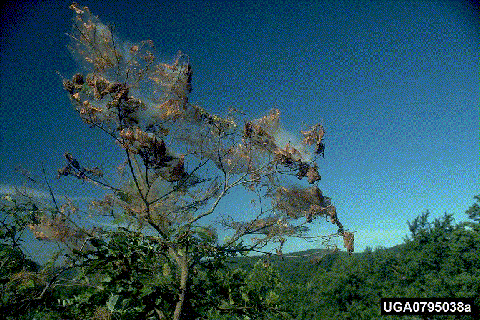
Fall Webworm Tent
Control
Control of all three of these pests is essentially the same. Destroying the tents, especially when the tents are small, is an effective way of getting rid of the caterpillars. The best time to do this is around dusk or early morning when the larvae are in the tent. Burning the tents should be avoided because the fire and intense heat may damage the tree. On smaller trees, egg masses may be pruned off and destroyed. For larger trees or trees that have several nests, a spray may be needed. Bacillus thuringiensis (Bt) and a number of chemical insecticides are effective against these caterpillars. If an insecticide application is made, it should be made when the larvae are small and easiest to control, not when they are full grown and have already done their damage. The insecticide should be applied in the evening or early morning when the insects are in the nest. A high pressure spray may be needed in order to get the insecticide into the tents.
Revised: 1/04
CAUTION! Pesticide recommendations in this publication are registered for use in Kentucky, USA ONLY! The use of some products may not be legal in your state or country. Please check with your local county agent or regulatory official before using any pesticide mentioned in this publication.
Of course, ALWAYS READ AND FOLLOW LABEL DIRECTIONS FOR SAFE USE OF ANY PESTICIDE!
Images: The fall webworm photo was obtained from the Gypsy Moth Home Page at Virginia Tech. The photos of the Eastern tent caterpillar tent and egg mass, the forest tent caterpillar larva, and the fall webworm tent were obtained from the CD: G.K. Douce, et al., 1995, Forest Insects and Their Damage Vol. I and II, Southern Cooperative Series Bulletin No. 383-December 1995, Southern Forest Insect Work Conference SERA-IEG-12. These are copyrighted images. They may be copied and used, in whole or in part, for any non-profit educational purpose provided that all reproductions bear an appropriate copyright notice. Any commercial or other use of the images requires written permission of the SFIWC and the individual photographer or organization.
